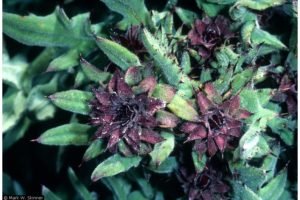
Fountain Thistle
Plants Summary
There are thousands of kinds of plants. Plants are producers and provide food and shelter for many animals. The basic structures of a plant are the roots, stem or trunk, and crown which usually includes the leaves, flowers, fruits and seeds
Though some plants are parasites and live off of other plants, most plants make their own food. The leaves are the food factories. Chlorophyll is the magical substance that gives them their green color and allows them to make their food from sunlight. Using sunlight for energy and H2O and CO2 they make the sugar glucose. 6 CO2 + 6 H2O + light energy = C6 H12 O6(sugar) + 6O2. The long chains of sugar molecules form the cellulose of plants. Another interesting thing is that if you are in the hospital and in need of nutritional strength they give you glucose.
Plants must have sunlight, water, CO2 from the air and nutrition to survive. They transpire through the little stoma located on the underside of leaves. These look like two little lips that open and close by shrinking or swelling. A plant will wilt or die if it doesn’t get enough water. Some will rot if they get too much water. They are as picky and individual as people!
Some plants like hot, some like cold. Some like it dry, some like it wet.
Some like shade, some like it sunny. Some are soft, some are hard.
Some are furry, some are thorny. Some are tiny, and some are huge.
Plants move! They may climb, crawl, float, or stand. Tropisms are the movement of plants in response to an external directional stimuli. Geotropism is a response to the force of gravity. Phototropism is when a plant moves towards light. Hydrotropism is when the roots of a plant move towards water. Roots are generally positively geotropic and grow downward. The roots are the sponges that soak up water and anchor the plant. Tropisms are controlled by differences in concentrations of growth hormones.
Some plants have leaves or flowers that open and close. In the mountains when the weather gets very cold rhododendron leaves will curl up. The sensitive plant closes it’s leaves if touched. Some flowers open and close at specific times like the morning glory, four o’clock, dandelion, or daylily. You might have students make a flower clock. Some flowers only bloom at night like the moonflower.
Plants cells have a cell wall that is lacking in animal cells. The wall gives the plant strength and support.
Plants come in a variety of sizes and colors. They may be white, orange, purple or many other colors. They grow from the soil, on bread, cheese, rocks, on other plants, in the ocean, lakes, deserts, and swamps. There are plants that look like animals and plants that look like stones. There are plants that live in trees like mistletoe, orchids, and Spanish moss. There are plants that climb like ivy, honeysuckle, grapevines, pumpkins, cucumbers, and morning glories.
Algae include some of the simplest plants know to man. They are mostly aquatic and range in size from one single cell living on trees, in snow, ponds and the surface waters of the ocean to strands of cells several meters long that make up seaweeds in the deep ocean. Algae in marine and freshwater plankton are important as the basis of food chains.
There are plants that act like animals. From spores slime mold crawls like a worm then becomes fixed like a stem. Some plants eat insects like the sundew, Venus flytrap, and pitcher plant. There is a fungus that catches worms with a lasso. My favorite is the microscopic euglena that has chlorophyll and can make it’s own food but moves and eats like an animal as well. Lichens are two plants that are partners. One makes food and the other finds water. They may grow on bare rock and break rock down to soil.
The leaves of deciduous plants change colors in the fall because cork forms in the stem of the leaf and cuts off the water supply. When there is no water the chlorophyll green fades. Carotenes and anthocyanins in the leaves give other colors. If sugar is trapped then the color turns red or purple. Leaves turn brown when dry and are dead. Galls in the leaves or stems of plants are bumps where insects have laid eggs. When a leaf falls from a plant it leaves a scar. Many of these scars look like cute little faces. The scar left by a leaf from the Tree of Heaven is the shape of a heart!
Some plants are poisonous or have poisonous parts such as poison oak and ivy, mistletoe, castor bean, yew, oleander, poinsettia, mountain laurel, wild cherry, and rhubarb
Plants may be evergreen or deciduous. Evergreens don’t freeze in winter and their leaves are tough and they remain on the plant through the winter. Deciduous plants lose their leaves in the fall.
Plant Biomes:
Pond – cattails, lilies, lotus, duckweed, algae, bulrush, calamus
Ocean – seaweed, kelp, diatoms, eelgrass, sea lettuce, sargassum
Desert – cactus, yucca, stone plant
Rainforests are tropical and plants are green all the time.
Mountains have many biomes
Plants may partner with other life; the indian pipe plant partners with a fungus, the monarch butterfly partners with milkweed.
Plants give us food (seeds feed the world), medicine, spices, drinks, clothing, jewelry, dyes and many more things than I can mention. I love plants!
EASY PHOTOTROPISM EXPERIMENT WITH KIDS
